Ground Report: From Delhi to Bihar … on a cycle rickshaw
In the absence of transport facilities due to the lockdown to control Covid-19, many set out from Delhi to their villages on bicycles, cycle rickshaws and thelas. Meet Ashok Yadav who has to cover a distance of 1,400 kms

A journey of about 1,400 km from Delhi to Purniya on a cycle rickshaw — the mere thought seems unsettling. But that is what Ashok Yadav (45 years) decided to do when he set out from Delhi to his village on March 27. He was one among the thousands of labourers who left Delhi to prevent starvation during the 21-day lockdown imposed to stop the spread of coronavirus.
Yadav said he ran the rickshaw near Anand Vihar in Delhi. When Gaon Connection met him, he had already travelled more than 700 kilometres, having crossed Lucknow and Barabanki, and was headed towards Bihar on NH-28. His village falls in the Srinagar block of Purniya district in Bihar.
Yadav, along with a fellow labourer, was returning home with two bags, a blanket, a two-litre bottle filled with water and an empty bucket hanging from behind the rickshaw. He said he had not had a meal for many hours and that he was left with very little money. The help from people feeding the hungry was not enough to take care of the huge number of labourers on the move, he said.
“There was no work in Delhi. I would have died of hunger had I remained there. Not able to find any bus or train, I set out on my rickshaw six days ago. It will take at least five more days for me to reach my village. We two take turns to pedal the rickshaw,” Yadav said, wiping his face with a long towel (angocha) with which he covered his head from the sun and his nose and mouth to protect himself from the coronavirus.
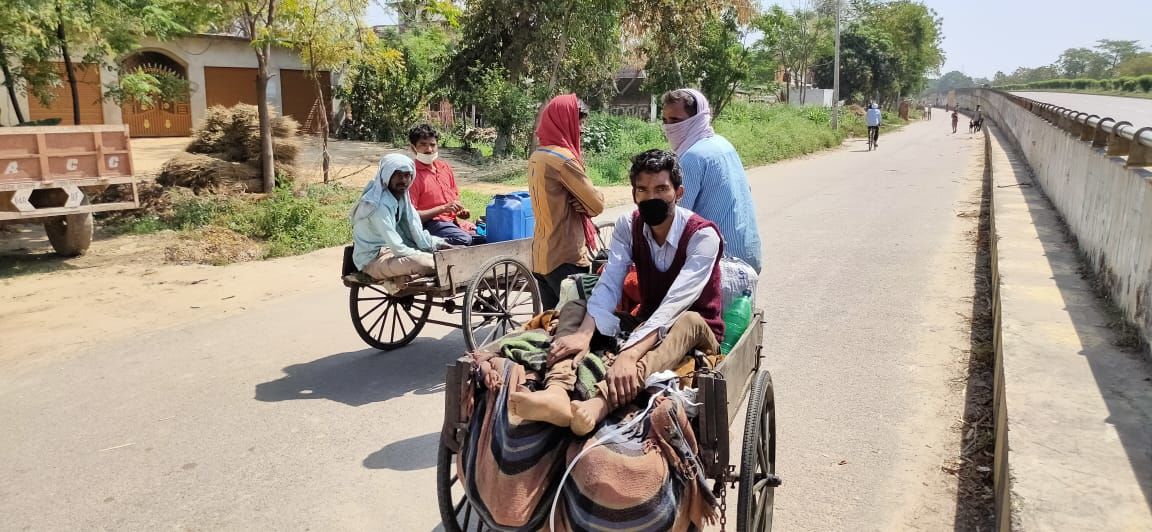
About 300 metres ahead of Yadav on the highway, Santosh Paswan and Chote Lal Paswan, too, were making their way from Delhi to Muzaffarpur in Bihar in a form of cycle-rickshaw called thela that is used for carting goods. In the National Capital Region (NCR), they lived near the Bhopura border in Ghaziabad adjoining Anand Vihar, the area that falls in Sahibababad (Uttar Pradesh).
Before the lockdown, Santosh used to sell ice cream. He left the NCR on March 28. In a hurry to reach Muzaffarpur, a place famous for litchi, he was desperately looking for a bus.
But why did they leave NCR, when the government had assured them food and safety. Chotey Lal Paswan (45 years), who sat behind on the thela, said, “We stayed back a full week after work stopped. No food could be found. We didn’t have ration at home, when we went out to get it, the police beat us. What were we supposed to do? How long could we have suffered like that?”
Santosh Paswan, pulling the handcart, weighed in before Chotey Lal could finish. “What would we have done there? We did not have money. If you reach your village, you will not die hungry at least. There is food cultivation, ration need not be bought. About 50-100 people around our village had already left, we have covered 700 kilometres, and now 350 kilometres remain.”
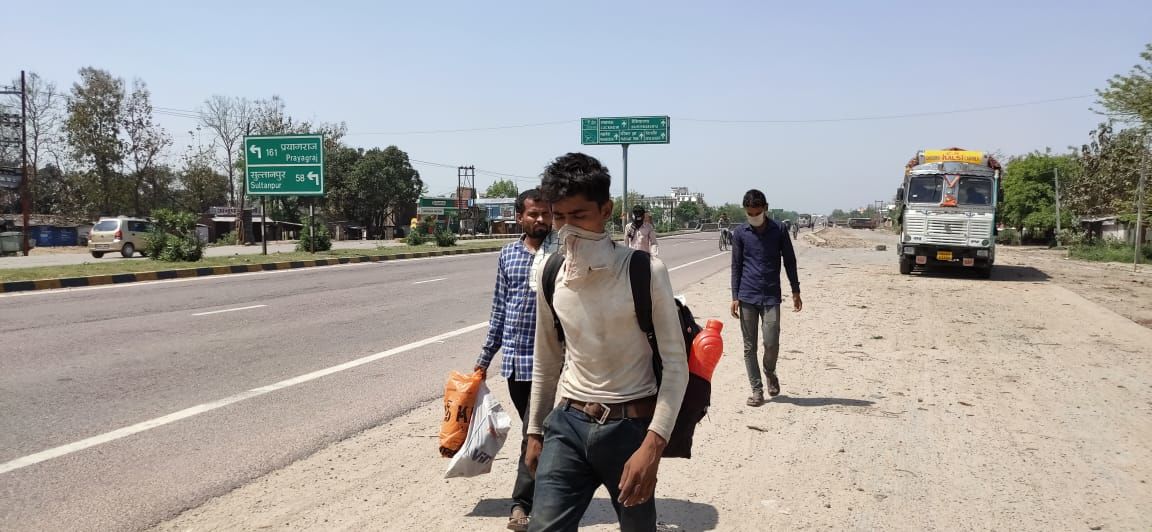
The coronavirus pandemic had started affecting the availability of work since Holi in Delhi. However, the janata curfew on March 22 and the 21-day lockdown since March 25 had a direct impact on the livelihood and employment of thousands of labourers and workers. They began returning to their villages and the governments failed to convince them that they would not go hungry. Only when crowd started swelling at the Anand Vihar bus terminal in Delhi did the plight of the workers get some attention and the government and other agencies started to help them.
However, the fear of the virus, the apprehension that they could end up with starvation, the rumours of a the lockdown extending beyond the 21 days, and the lack of transport facilities due to the strict enforcement of the lockdown forced the labourers to return to their villages on foot.
On March 28, the Yogi Adityanath government of Uttar Pradesh started operating 1,000 buses for the labourers, but by then thousands like Ashok Yadav and Chhotey Lal Paswan set out on foot or bicycle rickshaws to their homes.
Labourers and workers from several states, including Uttar Pradesh, Bihar, Jharkhand, West Bengal and Rajasthan, Madhya Pradesh, have had a long history of working in Delhi, Mumbai, Pune, Bengaluru as well as Haryana, Punjab, and other south Indian states.
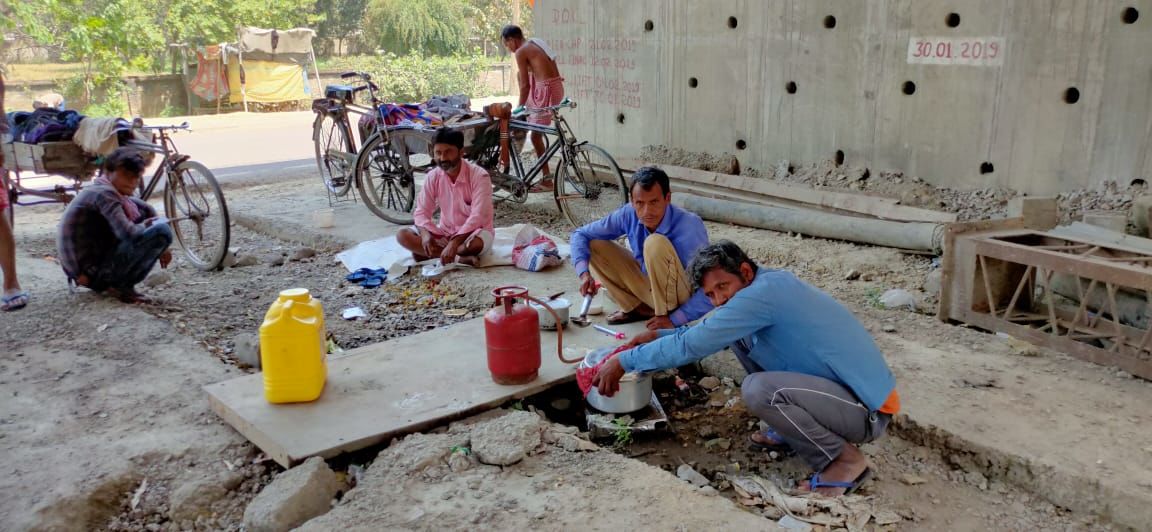
Uttar Pradesh shares its border with Bihar at several districts. Most labourers coming through the NH-28 Delhi-Faizabad-Gorakhpur route belonged to several districts of Purvanchal in Uttar Pradesh, including Barabanki, Ayodhya, Basti, Sant Kabir Nagar, Gorakhpur and Siddharthnagar. Most labourers were going towards Bihar through the Gopalganj border to Gopalganj, Muzaffarpur, Siwan, Vaishali, Patna, Samastipur, Madhubani, Gaya and Sasaram.
On March 25, when the 21 day lockdown came into force, hundreds of rickshaw and thela pullers were seen on the highway leading to eastern UP and Bihar.
“People everywhere were saying the disease is spreading, stay at home. But where could we have stayed? We worked all day in the Wazirpur industrial area and slept under the bridge at night. The police started
to drive us away from there. So I gathered whatever I had and left,” said Dasrath Paswan, who pulled a thela in the industrial area.
He said he had gone hungry for several nights since he left Delhi.
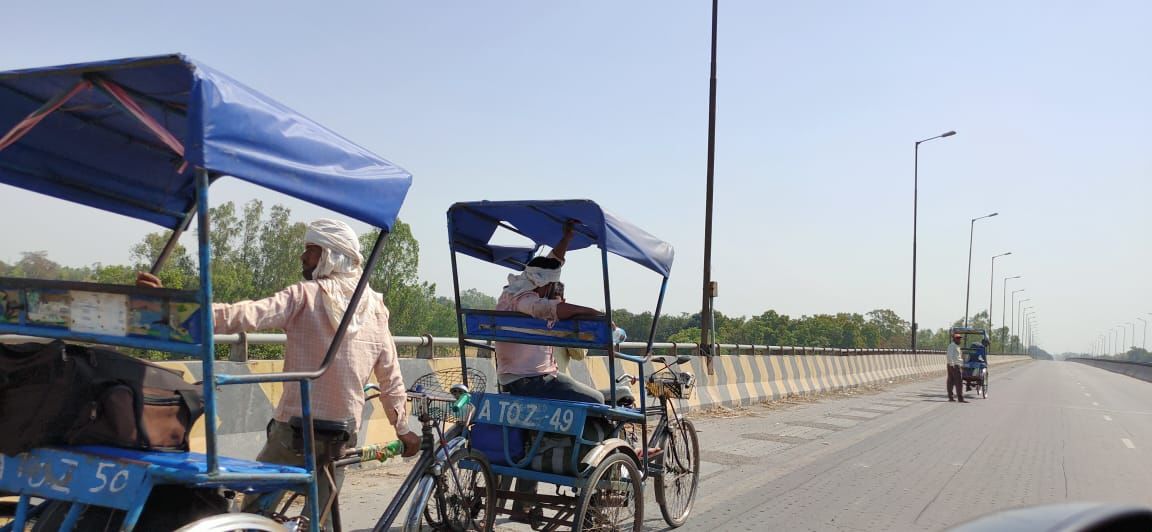
Ramesh also left Delhi in his thela. He could pack all his belongings because he left in a hurry. He packed all he could in a rug and put it behind his thela and started his journey to his village in Uttar Pradesh.
In Ayodhya, Lalbabu Singh, of Debu Dehri village of Ara district in Bihar, was cooking a meal for him and his eight companions who had left the NCR on three thales and two bicycles, which were parked beneath an under-construction flyover.
Singh was making dal-rice on a stove fuelled by a small LPG cylinder. He said the group had had just one meal a day for the five days they had travelled to conserve food items.
“I worked in a wire-making factory in Ghaziabad, carrying wires. How could I have lived there when the factory was closed? I had not received any payment from the contractor. I had to leave for my home. If I stay alive, I shall think about earning later,” Singh said.
A companion of Lalbabu, who had cycled from Delhi to Ayodhya and had to go to Ara, showed his feet and said, “The feet is so swolllen that I can’t wear my slippers, but what else can I do? If I have to die, I will rather die trying to reach home. At least, I will be able to see my family.”
Ayodhya district magistrate Anuj Kumar Jha said, as per official statistics, more than 3,000 migrant labourers returned to the district on March 28, 29 and 30 and that they were being screened. More than 175 teams are keeping an eye on the people who have not returned, he said.
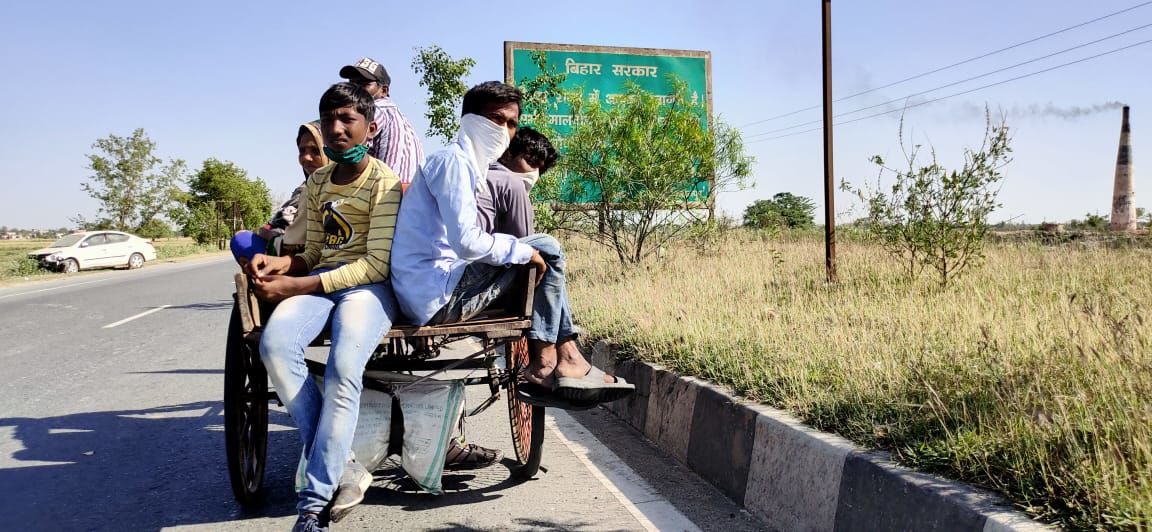
Many quarantine centres have been set up a few kilometres apart in almost every district of UP along the highway. A few miles away from the border of Basti district, along the same highway, a private school has been converted into a centre in which some labourers who had returned from Delhi and Mumbai are currently housed.
Ashok Patel, a resident of Janaki Chaba in Bilaspur district In Chhattisgarh, is currently housed there with his wife, small children and some people from his village. “We lived under a bridge in the Nizamuddin area in Delhi. We had no problem, but since everyone began fleeing, we, too, got scared and set out to go to our village. On the first day, we walked the whole way, then we hitched rides on trucks. We will stay here till April 14 when the lockdown ends,” Patel said.
But those on the road have no intention of stopping. “Now there is no point stopping midway. I just want to reach the village,” said Shahabuddin, who is returning from Manesar in Haryana to Gaya in Bihar.
Mohammad Imran, just 18, managed to cycle his thela for more than 800 kilometres from Delhi and had to cover another 550 km to reach his home in Purniya district. “I used to cart goods in Azadpur mandi in Delhi. When no work was left, I took my thela and left on Sunday morning. In a few days, I will reach home. I am quite close,” he said. “When all this is over, I will go back to Delhi. I have to return to Delhi to earn a living. There is nothing in the village for me to do to feed myself.”

